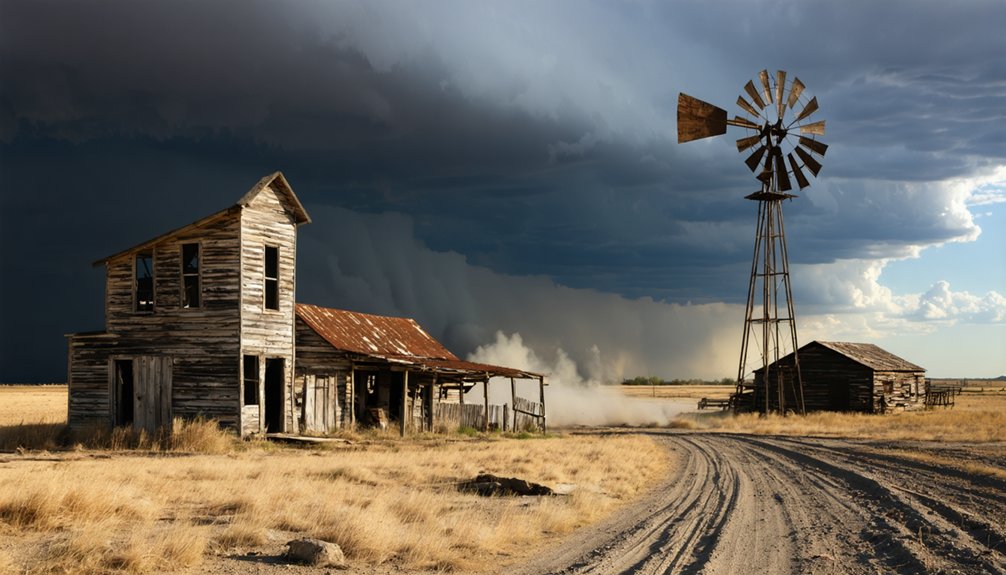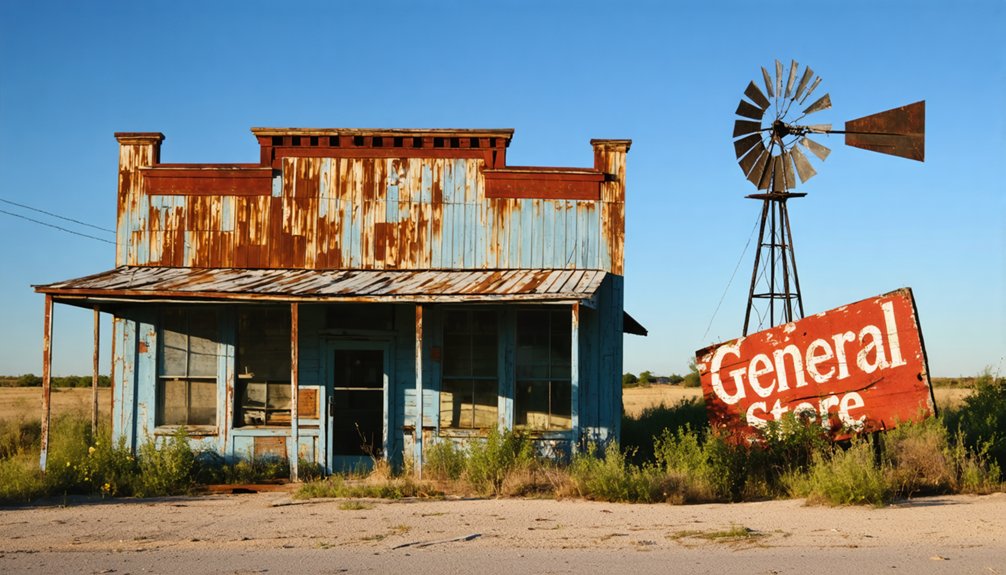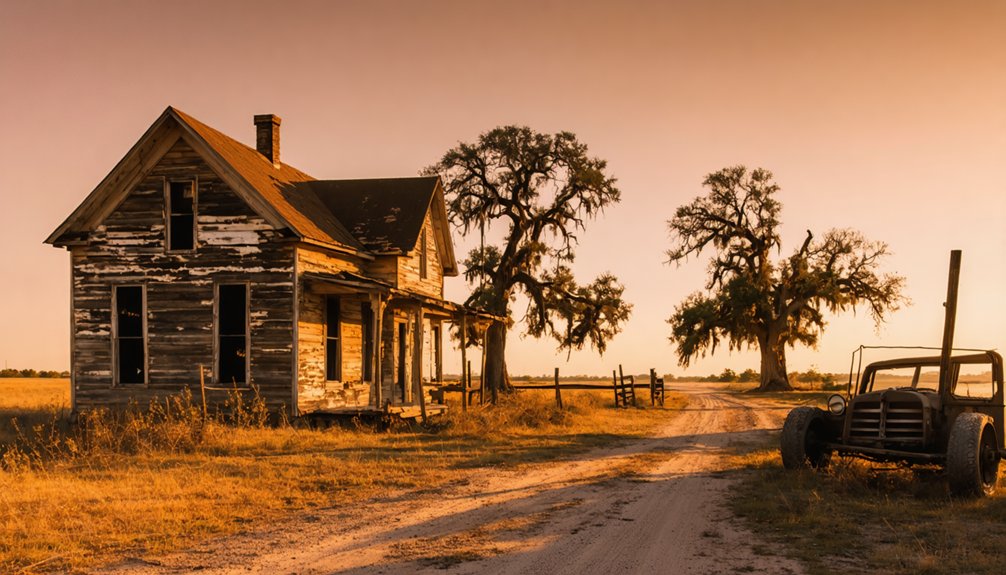You’ll find Three Oaks tucked away in Wilson County, Texas, where it emerged as an agricultural settlement in the early 1900s. During its peak around 1906, the community produced nearly 58,000 bales of cotton and supported a vibrant rural economy with schools, stores, and farming families. Today, this ghost town‘s weathered ruins, historical markers, and abandoned structures tell the story of its dramatic rise and fall, with deeper secrets waiting in its cultural legacy.
Key Takeaways
- Three Oaks is a ghost town in Wilson County, Texas, established in the early 1900s and named after distinctive trees.
- The town reached its peak in 1906 with cotton production of 58,000 bales before declining due to economic and agricultural challenges.
- The Great Depression, agricultural mechanization, and environmental issues like droughts led to the community’s abandonment.
- Historical remnants include building foundations, roofless ruins, and an 1887 jail known for reported ghost sightings.
- The town maintains approximately 150 residents since 2000 and is officially recognized as one of Wilson County’s ghost towns.
The Birth of a Rural Texas Community
As the twentieth century dawned, Three Oaks emerged as a rural settlement in southern Wilson County, Texas, establishing itself roughly eleven miles south of Floresville along what would become Farm Road 1344.
The community’s origins coincided with Texas’s broader rural expansion of the early 1900s, when pioneering families ventured into undeveloped areas to establish new homesteads and farming operations. The settlers remained vigilant against extreme weather events that frequently threatened small Texas communities.
You’ll find the settlement’s name likely derived from distinctive trees that marked the landscape, creating a natural landmark for the area’s first residents.
These early settlers quickly laid the groundwork for a self-sufficient community, building homes and essential structures while cultivating the surrounding land. Similar to many communities that grew alongside railroad expansion, Three Oaks hoped to benefit from new transportation routes.
Their determination to carve out an independent existence shaped Three Oaks into a viable farming community that would persist for decades to come.
From Boom to Bust: Three Oaks’ Rise and Decline
While Three Oaks initially flourished as an agricultural hub in the early twentieth century, its prosperity proved short-lived.
The town’s economic resilience was tested during the Great Depression when cotton prices plummeted and drought conditions devastated local farms. Like the town of Lobo, which suffered from severe water scarcity, Three Oaks struggled to maintain its agricultural viability. Despite its strong community identity built around agriculture and railroad commerce, Three Oaks couldn’t withstand the mounting pressures of the mid-20th century. Much like Paducah, the town saw two-thirds of residents leave for better opportunities elsewhere.
Like many rural communities, Three Oaks’ agricultural roots and railroad ties couldn’t shield it from the crushing weight of economic hardship.
The shift from rail to truck transportation undermined the town’s geographic advantages, while agricultural mechanization reduced labor needs. As families sought opportunities elsewhere, crucial institutions like schools and churches closed their doors.
Environmental challenges, including soil depletion and recurring droughts, dealt the final blow to Three Oaks’ farming-dependent economy, transforming a once-thriving rural center into another Texas ghost town.
Life in Early 20th Century Three Oaks
In early 20th-century Three Oaks, you’d find families working small farming tracts, tending to cotton crops and livestock as part of their daily routines. The community reached its agricultural peak when farmers produced nearly 58,000 bales of cotton in 1906.
Your children would’ve attended the local school, which served as an educational hub for farming families throughout the community.
If you were a tenant farmer or sharecropper, you’d have joined many others working the rich farmland, though the arrival of the boll weevil would later challenge your agricultural way of life. With light and dark loamy soils ideal for agriculture, farmers were able to cultivate successful crops before the economic downturn of the Depression era.
Daily Farm Life
Life on Three Oaks farms during the early 20th century centered around cultivating diverse crops like corn, maize, peanuts, and legumes.
You’d find families tackling farm chores with basic manual tools and simple machinery, adapting to the challenges of each growing season. Many of the area’s German immigrant families focused on growing enough to sustain their households. Seasonal planting demanded careful timing and attention to weather patterns. The nearby Texas and Pacific Railroad helped farmers transport their goods to larger markets.
Your daily routine would’ve shifted dramatically after the 1930s boll weevil infestation forced a change from cotton to other crops.
Despite these challenges, you’d join other farmers at local markets to trade goods and maintain economic stability.
The surrounding countryside provided a backdrop for your labors, with wildlife and natural ecosystems flourishing alongside the farmland.
When you weren’t working the fields, you’d gather with neighbors at the Community Center, strengthening the bonds that kept Three Oaks resilient.
Local School Activities
The local schoolhouse stood as the heart of Three Oaks’ educational and social life by the mid-1930s. You’d find students learning core subjects like reading, writing, and arithmetic in basic facilities that initially operated without electricity.
The school building served multiple purposes, hosting school plays and community gatherings that brought everyone together. Like many rural schools in the area, instruction was given in both German and English languages.
At year’s end, you could join fellow residents for public examinations where students showcased their achievements, followed by celebratory picnics and dances.
The auditorium buzzed with theatrical performances and graduation ceremonies, while the grounds came alive with baseball games and sporting events. Students often participated in mental arithmetic and other academic subjects typical of the era’s curriculum.
These activities weren’t just about education – they helped preserve local traditions and strengthen community bonds in this small rural setting, where graduating classes sometimes numbered as few as six students.
Agricultural Heritage and Economic Impact
While cotton initially dominated Three Oaks’ agricultural landscape before the 1930s, a devastating boll weevil infestation forced local farmers to diversify into flax, peanuts, corn, and other vegetables.
This crop diversification proved vital for community resilience, as farmers adapted to changing market demands and environmental challenges.
You’ll find that Three Oaks’ agricultural heritage was supported by robust infrastructure, including cooperative facilities, general stores, and machinery repair shops.
The town’s commissary even issued its own currency, reflecting its status as an agricultural company town.
When the local sawmill burned down in 1935, farming remained the economic backbone, though many residents later incorporated oil production into their operations.
While the population eventually declined, the farming legacy shaped Three Oaks’ identity as a close-knit rural community.
Weather Patterns and Environmental Challenges

Located within Texas’s humid subtropical zone, Three Oaks experiences dramatic weather variations that shape its environmental landscape.
Three Oaks reflects Texas’s dynamic climate, where shifting weather patterns continuously mold the natural environment.
You’ll find summer temperatures soaring above 100°F, while winters remain generally mild but unpredictable. The region’s weather variability is evident in its rainfall patterns, with annual totals swinging from 20 to over 50 inches.
The area’s climate resilience is tested by frequent environmental challenges. You’ll encounter intense summer thunderstorms, periodic droughts, and occasional tropical systems that can trigger flooding.
The soil and vegetation adapt to these extremes, but they’re vulnerable during prolonged heat waves and dry spells. Recent decades have shown rising average temperatures and more erratic precipitation patterns, making the local ecosystem increasingly susceptible to weather-related stress.
Demographic Shifts Through the Decades
Since its establishment around 1900, Three Oaks underwent significant demographic transformations that mirror broader trends in rural Texas communities.
You’ll find that the town’s population trends followed a pattern common to many agricultural settlements: initial growth in the early 1900s led to a thriving community with a school, church, and multiple homes by the 1930s.
The post-World War II era brought dramatic changes as rural migration to urban areas depleted the town’s population.
Many residents, particularly younger generations, left for economic opportunities in cities. While most small rural communities became ghost towns, Three Oaks managed to maintain some liveliness.
Remnants and Landmarks Today

Today’s visitors to Three Oaks can still find tangible reminders of the town’s past scattered across its landscape. You’ll discover building foundations, skeletal remains of structures, and the occasional roofless ruin that hints at the once-thriving community.
Historical markers dot the area, providing insight into prominent families and significant events that shaped the town’s heritage.
The most notable structure you can explore is the 1887 jail, which has attracted attention for reported ghostly sightings and unexplained phenomena.
While many buildings have succumbed to weathering and vandalism, some structures remain on private property. Access requires traversing rugged terrain, but designated parking areas make exploration possible.
Local preservation efforts continue, though most sites remain in various states of neglect, slowly surrendering to the elements.
Cultural Legacy in Wilson County
While Three Oaks stands as one of Wilson County’s 31 ghost towns, its cultural legacy endures through rich traditions of music, storytelling, and community gatherings.
You’ll find its heritage preserved in folk songs like “Barbara Allen” and tales of the Connally brothers, which connect families to the county’s history. Summer evenings once buzzed with community resilience as neighbors gathered for homemade ice cream and music under starlit skies.
The town’s cultural preservation efforts continue through the Wilson County Historical Society, which maintains archives of Three Oaks’ stories and records.
Though its population has dwindled to around 150 residents since 2000, the community’s impact on regional identity remains significant, exemplifying the broader narrative of rural Texas settlements and their transformation throughout the 20th century.
Frequently Asked Questions
Are There Any Ghost Stories or Supernatural Legends Associated With Three Oaks?
You won’t find haunted tales or spectral sightings in this location’s history. Unlike other Texas ghost towns, there’s no documented evidence of supernatural activity in historical records or community accounts.
What Happened to the Original Church Records and School Documents?
You won’t find official records showing what happened to the church history or school documents – no centralized preservation efforts exist. Your best leads are local historical societies and surviving residents.
Did Any Famous or Notable People Come From Three Oaks?
Like whispers in prairie wind, you won’t find any famous residents or historical figures from Three Oaks. Research shows the small community’s families stayed locally prominent but never gained wider recognition.
Where Did Most Three Oaks Residents Relocate to After Leaving?
Based on relocation patterns, you’ll find most residents moved to Floresville, about eleven miles north, where they maintained community connections while gaining better infrastructure and economic opportunities in the larger town.
Are There Any Annual Events or Reunions Held by Former Residents?
You won’t find any annual gatherings or community nostalgia events among former residents – there’s no documented evidence of reunions, festivals, or organized celebrations being held by those who left.
References
- https://www.youtube.com/watch?v=j1vcl01ulo8
- https://www.southernthing.com/ruins-in-texas-2640914879.html
- https://www.wilsoncountyhistory.org/talk-three-oaks
- https://www.expressnews.com/news/houston-weather/article/texas-ghost-towns-extreme-weather-hurricanes-19874031.php
- https://en.wikipedia.org/wiki/List_of_ghost_towns_in_Texas
- https://www.mysanantonio.com/news/local/article/13-ghost-towns-in-Texas-to-visit-this-fall-5814625.php
- https://www.youtube.com/watch?v=NVUauBKe47M
- https://www.texasescapes.com/TOWNS/Texas-Ghost-Towns-2-Central-Texas.htm
- https://mix931fm.com/cherokee-county-ghost-towns/
- https://www.tpr.org/texas/2017-10-30/boo-the-rise-and-fall-of-texas-ghost-towns



